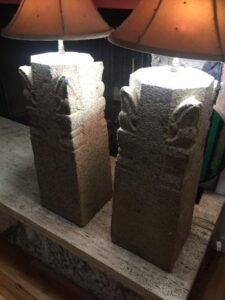 JE wrote that she found these lamps at her favorite thrift store, Destined for Grace, in Santa Barbara about four years ago. The tag on them read: “From a Hindu Temple.” She wants to know more about them.
JE wrote that she found these lamps at her favorite thrift store, Destined for Grace, in Santa Barbara about four years ago. The tag on them read: “From a Hindu Temple.” She wants to know more about them.
These Hindu lamps are carved stone and she hired a trainer from her local gym to carry them out of the store to her car and then in her house. They weigh about 250 lbs each. You see in the photos how somebody drilled the central post and electrified them. This theme appears a lot in early lighting- take something fabulous and making it into a lamp. Electricity in the beginning of the 20th century was RARE, and lighting fixtures reflect that wonderment.
Researching the form
I learned the attribution to a temple may be correct, because of their form. They’re square with rounded, almost oval designs, to the top, of stylized lotus leaves and a central small lotus bulb in the canted corners. The lotus form gave me a clue. Hindus built temples where lotus and other flowers bloomed, near water, where water birds, and their sounds, thrive. If the architect doesn’t find water naturally available in the building of a scared structure, a temple may include a pond for lotus flowers, and of course birds, creatures of the sky.
This pair of columns made into stone lamps are shaped in a square. The square as an element of “divine geometry” means in the Hindu philosophy the essences of humanity and living a good life. The four elements of a good life, echoed in that square, and in Hindu architecture, are Artha (prosperity), Kama (desire), Dharma (ethics), and Moksha (self-knowledge). When a knowledgeable architect designs a square column and his stonemason cuts it this way, we see the tangible reflection of the four elements.
How did these theories in stone carving come to be?
The principles go back to before the 4th century CE, called the Gupta dynasty. By the 7th century, Hindu scholars wrote texts about how to design and build.
The square means something to those who understand the containment of fire. The fire pit is a square, sacred to the fire altar of Agni. So, you see the resonance of “square,” and rock, and of course water, the opposite element of fire.
The square holds great significance because it represents the four cardinal elements and four directions we face as humans. I learned the square, because it’s abstract, is divine perfection. The circle is accessible and earthly, as we see it in nature in the sun, the moon, and the arch of the rainbow.
I love these Hindu lamps
They enlighten…literally! They speak about the divine symmetry of the circle and the square, but they also echo the belief in Hindu thought that all things are one, connected. So, the square form, the lotus design, the water, and the rock, are here personified. This is the key to the phase to “circle the square.”
To make a piece of rock LIVE as a natural form exceeds difficulty, and I know of no way of telling the age of JE’s lamp bases. But the stone also shows a feminine touch, as temples employed women to polish the square stone, and sometimes make them glow like mirrors.
Rock cut architectural features and all rock cut architecture like this amazes me. If these were ever part of such an historic structure I’ll cry that they’re not still a part. Rock cut architecture is based on the premise that caves are sacred. As early as the 8th century, architects in India excavated volcanic basaltic cliff rock into caves, doing what Michelangelo did eight centuries later and taking away what was NOT necessary. These incredible craftsmen created massive temples, such as the largest, Ellora, and cut way the cave until it resembled a masonry or wooden place of worship.
I speculate on these monumental Hindu lamps, JE, but the story of their heritage seens fascinating. Let’s put a value of $800 each for starters.
Pingback: Alter Echoes Ancient Hindu Tradition - Elizabeth Appraisals